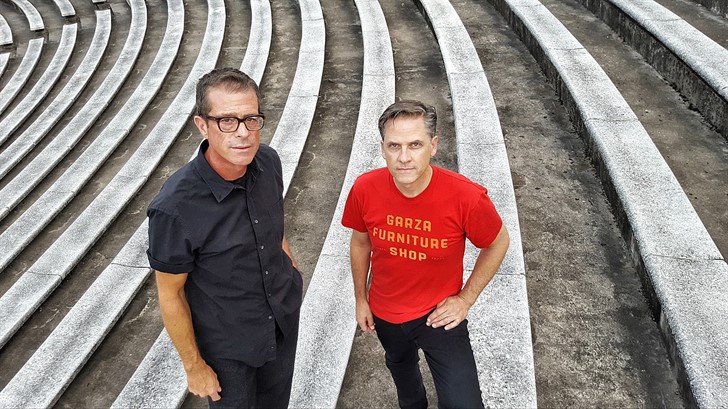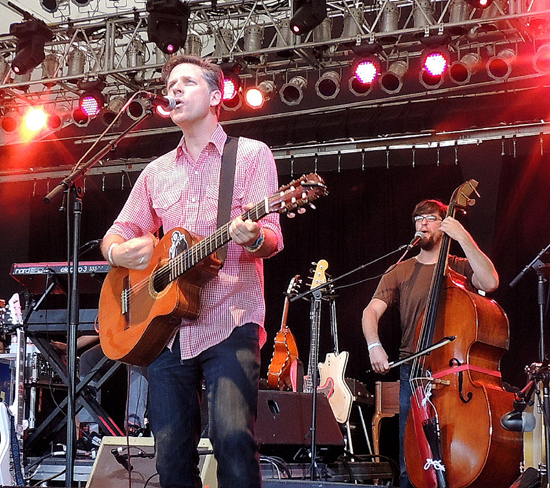Calexico: Cutting Through the Chaos

A new Calexico album, in the Donald Trump era, carries a crucial cultural weight. The president’s signature campaign promise was to “Make America Great Again,” and a major part of that plan involved building a massive wall on the U.S./ Mexico border—a supposed effort to keep out drugs and criminals. For Calexico, a multicultural band named after a California city on that very border, the only natural response was to protest through perseverance—to be a model of inclusivity in the face of wide division.
“We’re certainly in some tough and confusing times,” says singer-songwriter Joey Burns, who co-founded the project with drummer John Convertino in 1996. “After the last presidential election, and going into 2017, John and I were scratching our heads, like, ‘What do we do now?’ As a band that embraces a lot of different styles musically, and has members who come from different backgrounds and countries—Germany, Spain, the Southwest, Mexico, the U.S.—we just realized we had to start writing and recording, and get back on the road as soon as possible.”
That sense of urgency set Burns on the path toward Calexico’s cathartic ninth LP, The Thread That Keeps Us, a loosely connected song cycle about two children of different cultures who unite to confront bigotry and environmental destruction.
“I didn’t give the characters names, but I kinda pictured them,” he says. “They come from different backgrounds. One’s family speaks Spanish at home; the other speaks English. They’re both trying to come together and battle maybe offshore drilling or some kind of environmental development or getting rid of the rainforest. I thought, ‘I’m going to start off with these characters, and I feel like I’m looking through the lens of a Wes Anderson camera. On one hand, it felt incredibly nostalgic, and on the other, really poignant and relevant to what’s happening today. It was really helpful for me.”
The narrative unfolded in early 2017 as Burns began work on raw, minimalist demos at his family’s home in Tucson, Ariz. “I sat right at our piano, and I bought a really cheap Yamaha drum machine from [bandmate Sergio Mendoza],” he says. “It has 100 beats, and you can alter the tempo. The kids loved the drum fills. I’d sit here with a guitar or piano, just hammering out some ideas— anything from Latin to folk to rock to experimental. It all got recorded on this phone.”
With Convertino—Calexico’s only other official member—living in El Paso, Texas, it was challenging to plot their next move. But when Burns and engineer Craig Schumacher visited the drummer’s new house, they stumbled upon an unexpected plan. “We were eating dinner, and Joey was like, ‘I love your house. I like the vibe here. Let’s record a little bit here,’” Convertino says. “There was a stretch of time where my wife was out of town at a conference, so it was just us and my son. We just kind of moved some furniture around. I was telling Joey how good my drums sounded in one particular room, so we set up in there and in the hallway. With today’s technology, you can pretty much record anywhere, so that was a great way of easing into making a record. We were working on a soundtrack [Calexico contributed music to the 2016 documentary The Lure], so it was a nice way to get the creative ow happening without the pressure of making a record.”
The duo contemplated moving their operation to Sonic Ranch, the residential recording studio used by acts like Animal Collective and Band of Horses. “As we were driving back, I said, ‘Where do we want to be in June?’” Burns recalls. “Do we want to be where it’s going to be 120 degrees, or do we want to go somewhere else?” Hoping to avoid a heat stroke, they regrouped at their friend John Baccigaluppi’s Panoramic House, an innovative vacation home and studio built from recycled materials and overlooking Stinson Beach in Northern California.
This idyllic setting seeped into the themes of Burns’ new songs, guiding the actions of his characters. The turning point was daydreamy folk-pop tune “The Town & Miss Lorraine,” which sparked a vision. “What would it be like if there were two characters: this boy and this girl who found each other, and they have this sense of friendship or young love but there’s something [deeper]? When you write the music, the music calls to you some kind of mood or feeling or direction. With the song ‘Another Space,’ I thought, ‘That’ll be this theme of time travel.’ The characters have to go through a series of events, for me, because I threw a lot of crap at them. I just wanted to see what would happen to them.”
The most obvious “character song” is lo- acoustic ballad “Girl in the Forest,” which Burns crafted with lyrical assistance from his six-year-old daughter Twyla. “I was sitting on the couch, playing music and, toward the end, Twyla started humming and singing along with me,” he says. “I thought, ‘OK, maybe this could be a project between Twyla and me. So I said, ‘Let’s go to the kitchen table and write down some ideas of what this song could be about. ‘Girl in the Forest—what does she do?’ I was thinking of Standing Rock and protesters, and standing up against the corporate machine and greed. At some point, Twyla said, ‘Why can’t it be about the girl in the forest communicating with the animals and all of nature?’ I said, ‘Of course, that’s even better! It’s simpler.’ That certainly became the spirit behind the album’s vision: the girl in the forest who is one with the animals, the flora and fauna.”
Some of the tracks—like closer “Music Box,” a love song for Burns’ children— didn’t originally spring from the core narrative. But the frontman has since discovered the connective tissue. “With ‘Music Box,’ I was like, ‘How does that apply? Maybe that’s our main character, or both main characters, looking back, like I’m looking back at my life. Maybe that song is like 15 years later, what happens to these people?’ It can all make sense because there are no strict rules or guidelines.”
 Bonnaroo 2013 (Maureen Lauer-Gatta)
Bonnaroo 2013 (Maureen Lauer-Gatta)
Some of Calexico’s previous albums were highly collaborative: Convertino, for example, co-wrote seven of the 12 tracks on their most recent LP, 2015’s Edge of the Sun. The drummer wasn’t directly involved in the writing process this time around, but he preferred it that way. “Joey had a lot of songs more fully realized, so our collaboration wasn’t as much in that foray as some of our past records, but that was great for me in some ways,” he says. “It felt like the songs came together so much more quickly and spontaneously in the studio. On some of the earlier records, we were kind of woodshedding things out, or we’d jam and find the best parts of the jams and make songs out of that. For this record, it wasn’t that way so much. It was a bit more like [2006’s] Garden Ruin, where they were really solid songs that Joey had already demoed.”
For some drummers, it’s difficult to assert yourself into the writing process without a melodic vantage point. Convertino admits his collaborative process with Burns is pretty “complicated”—defining the push and pull between rhythm and vocal, figuring out where “song” starts and “beat” ends.
“I always think of this picture of Robbie Robertson and Levon Helm on the inside of The Band’s first record,” he says. “It’s a picture of them facing each other, and it’s just the two of them. I don’t know if it’s the classic picture that tells a thousand words, but I always think about it. Having a songwriter like Robbie Robertson playing with a drummer like Levon Helm, there’s this collaboration going on.”
For another example, Convertino also points to Winston Watson, his predecessor in Tucson roots-rock act Giant Sand. (Convertino and Burns first met during their mutual tenure in the group.) “Winston went on to drum with Bob Dylan for almost five years on the road, and there were times when Dylan would hire Winston for songwriting sessions,” he says. “He wouldn’t give him songwriting credit, but he would pay him extra and just throw ideas at him, which is pretty fascinating. It made me realize what happens in these band situations, and I know sometimes it can turn into a nightmare for people like Robbie Robertson and Levon Helm. Where do you draw the songwriting line? How do you determine what is actual songwriting? I feel like Joey’s been fair with me—when songs come up when we’re together, he’s like, ‘I don’t think I would have come up with that unless you were playing that kind of beat.’”
Calexico finished tracking their latest LP back in Tucson, recruiting their eclectic cast of collaborators—multi-instrumentalists Martin Wenk and Jacob Valenzuela, keyboardist Sergio Mendoza, bassist Scott Colberg and singer-guitarist/bouzouki player Jairo Zavala Ruiz—to add their unique magic. It’s the intricate details that make any Calexico album so unclassifiable, and there are numerous sonic textures here that raise the eyebrow—from the psychedelic guitar solo of bluesy “Voices in the Field” to the EBow noise on alt-rock sing-along “End of the World With You” to the Farfisa organ on the funky “Another Space.”
The Thread That Keeps Us could be Calexico’s wildest, toughest-to-pigeonhole LP—and these sideline members played a massive role. Mendoza wound up writing the music to art-funk centerpiece “Under the Wheels;” Zavala crooned Spanish lyrics over the thick Latin groove of “Flores y Tamales;” Wenk contributed the lonely, horn-led instrumental “Unconditional Waltz.” The cinematic centerpiece for the full band is “Thrown to the Wild,” which unearths an almost apocalyptic darkness.
“It’s all about standing on the edge of chaos and knowing that it’s natural—that it’s a part of life and you can’t control what’s going to happen,” Burns says. “Lyrically, it kind of takes a look at downtowns, cities, urban or suburban life and how we are distanced from reality by way of our anxieties, fears, drugs or addictions—even technology or social media. I wanted that song to be like a snapshot, a black-and-white photograph to see all the layers of our lives through more of a distorted lens, then open the song up to chaos and let chaos do its thing. Ultimately, the song should have been about 10 or 12 minutes long, but I thought, ‘Let’s try to keep it to about six minutes’ because I knew there was a lot of material we wanted to touch on. Live, I’m sure we’ll let it out and let it go wherever it wants to go.”
In 2018, the U.S.—and, really, entire planet—feels immersed in a similar chaos. But with The Thread That Keeps Us, Calexico are taking stock of the optimism that’s arisen in response.
“I’m giving some of my feedback and perspective from traveling, listening to the news, being in Arizona, being a father now,” Burns says. “And looking at the future: ‘Where is this going to lead to?’ Despite all the concerns and negativity that we all feel from the news, both nationally and internationally, I feel there are glimmers of hope. You can look to one another. Look to your kids. There’s talk of building a border wall, but that’s not what we need. We need more diplomacy; we need more openness and understanding. Songs like ‘Flores y Tamales’ are embracing those very themes: We may be separated and from two different cultures, but let’s come together and find a common ground. Let’s talk; let’s celebrate food…or coffee. Buy a stranger a cup of coffee! You just might help someone through a tough time. I guess that’s our thread: longevity, being consistent and open.”
This article originally appears in the March 2018 issue of Relix. For more features, interviews, album reviews and more, subscribe here.



















